The SSD Update: Vertex Gets Faster, New Indilinx Drives and Intel/MacBook Problems Resolved
by Anand Lal Shimpi on March 30, 2009 12:00 AM EST- Posted in
- Storage
The Bright Side: The Vertex is Nearly 3x as Fast
Immediately after I published the anthology, I asked OCZ for a shipping version of the drive. I wanted final hardware, updated firmware, shrink wrap, the whole 9 yards. Here’s what I got:
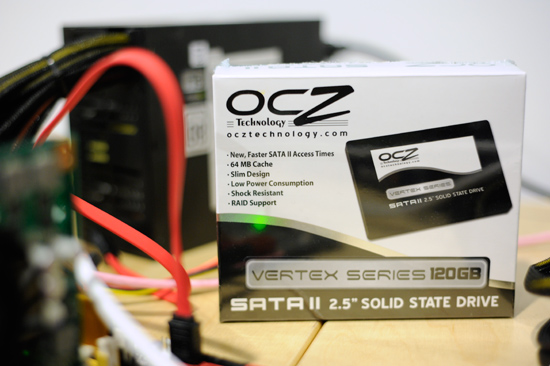
The drive itself looked identical to the first Vertex I tested, but the differences were all internal. The new drive used a new PCB layout, let’s pop the top off to see it:

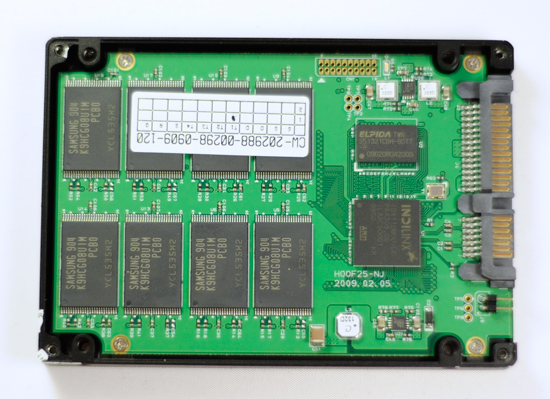
Oooh.
The major change on the new board layout is the addition of a 2-pin jumper on the back of the drive to allow the drive’s firmware to be updated by the end user. OCZ tells me that as of 1275, the jumper is no longer needed to update the firmware so it looks like it was a short lived change.
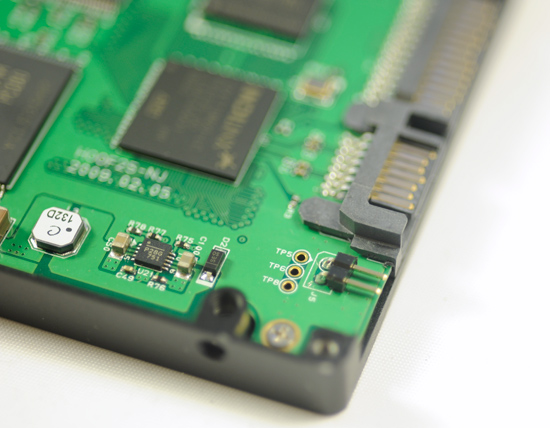
While OCZ claims that there’s significant validation done on each firmware revision, without a doubt it’s significantly less than what every Intel and Samsung drive goes through. There’s a certain amount of risk you take when jumping on the unproven hardware bandwagon, so as always proceed with caution. It’s worth looking into
While I haven’t done much testing on 1275, I can’t blame you if you want to try the firmware out right away because it is good.
I’ll start with the best news first. I looked at 4KB random write performance once again using iometer. This test is the same one I used in last week’s review; a 3 minute run, 3 outstanding IOs, 4KB random writes spread out over an 8GB section of LBAs. I filled the drive completely before running the test.
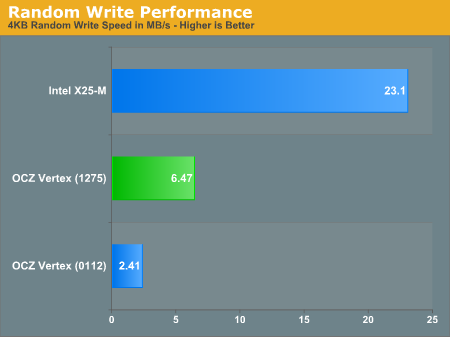
| Random Write (4KB Block, 3 IOs) | IOPS | Transfer Rate | Average Latency (ms) |
| Intel X25-M | 5923 | 23.1 MB/s | 0.51 ms |
| OCZ Vertex 1275 | 1656 | 6.47 MB/s | 1.81 ms |
| OCZ Vertex 0112 | 617 | 2.41 MB/s | 4.86 ms |
Yeah. It’s fast. Not quite as fast as Intel’s X25-M but it’s good. Average latency has dropped quite a bit. The Vertex using firmware 1275 performs used at about the level that the original firmware performed brand new. The Intel drive can still crunch through over 3.5x the number of IOs per second as the Vertex, but it also costs nearly 2x per GB. The Vertex proves itself an interesting value alternative.
I then looked at random read performance. Now most SSDs do just fine here, even the JMicron based ones.
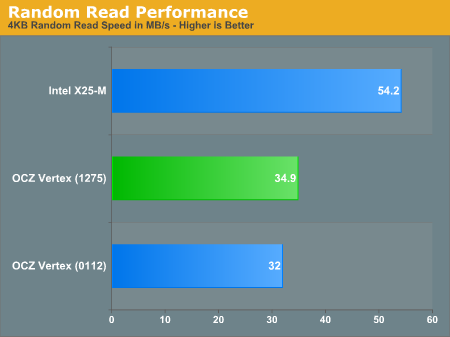
| Random Read (4KB Block, 3 IOs) | IOPS | Transfer Rate | Average Latency (ms) |
| Intel X25-M | 13883 | 54.2 MB/s | 0.22 ms |
| OCZ Vertex 1275 | 8931 | 34.9 MB/s | 0.34 ms |
| OCZ Vertex 0112 | 8184 | 32.0 MB/s | 0.37 ms |
The new firmware bumped up the Vertex’s performance by about 9%.
I spoke briefly with one of OCZ’s flash engineers and it seems like the reason the 1275 firmware is so much faster in random write speed is because of a bug in the 0112 firmware I tested with. There was apparently a problem with the 0112 firmware that prevented the controller from writing to as many flash devices as possible in parallel. The 1199 firmware fixed this, which explains why the sudden rush to ship the firmware. Unfortunately it looks like that version also has problems and thus we end up back at square one again. There’s no free lunch folks.
Sequential read performance showed a very marginal performance improvement:
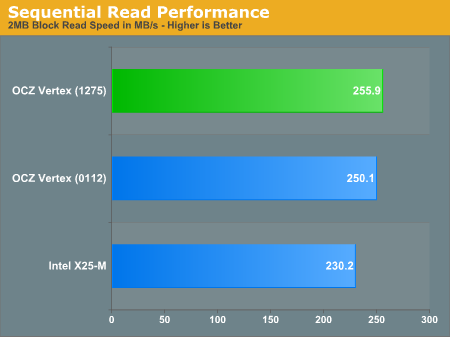
| Sequential Read (2MB Block, 1 IO) | IOPS | Transfer Rate | Average Latency (ms) |
| Intel X25-M | 115.1 | 230.2 MB/s | 8.7 ms |
| OCZ Vertex 1275 | 127.9 | 255.9 MB/s | 7.8 ms |
| OCZ Vertex 0112 | 125.1 | 250.1 MB/s | 8.0 ms |
But sequential write performance went up tremendously:
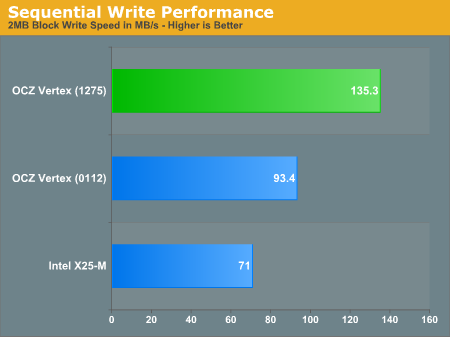
| Sequential Write (2MB Block, 1 IO) | IOPS | Transfer Rate | Average Latency (ms) |
| Intel X25-M | 35.5 | 71 MB/s | 28.2 ms |
| OCZ Vertex 1275 | 67.7 | 135.3 MB/s | 14.8 ms |
| OCZ Vertex 0112 | 46.7 | 93.4 MB/s | 21.4 ms |
The Indilinx (and most other) drives offer better sequential read/write speed than the X25-M. Intel optimized for the most important characteristics for a desktop: random read/write performance, while most other manufacturers optimized for sequential read/write. Indilinx is the first to seem to want to really drive sequential without completely forgetting about random performance.










73 Comments
View All Comments
Patanjali - Wednesday, April 1, 2009 - link
If Indilinx made the decision to do it off their own bat, OR it is not subject to a subcontracting agreement (that is, doing the firmware exclusively for OCZ), then they are free to offer it to all and sundry.In some industries, even though specific customers pay for changes, they are made available to all customers after a delay period.
It really depends upon who has who over a barrel.
siliq - Wednesday, April 1, 2009 - link
With Anand's huge article and other articles, it's clear that the sequential read/write thoroughput doesn't matter so much - all SSDs, even the notorious JMicron series, can do a good job on that metric. What is relevant to our daily use is the random write rate. Latencies and IOs/second are the most important metric in the realm of SSD.Based on that, I would suggest Anand (and other Tech reporters) to include a real world test of evaluating the Random Write performance for SSD. Because current real-world tests: booting windows, loading games, rendering 3D, etc. they focus on the random read. However, measuring how long it takes to install Windows, Microsoft Visual Studio, or a 4-GB PC Game would thoroughly test the Random Write / Latency performance. I think this is a good complementary of our current testing methodology
7Enigma - Thursday, April 2, 2009 - link
They did test that, see the FarCry 2 installation directory at the end of page 6.7Enigma - Thursday, April 2, 2009 - link
Page 5, page 5, edit, edit, edit...Patanjali - Tuesday, March 31, 2009 - link
I don't know if I missed it in the article, but I didn't notice the reason for the degradation.Is it:
a. Faults in the firmware
b. Faults in the controller
c. Faults in the flash devices themselves, or
d. Progressive increase in the proportion of the SSD blocks that need erasing before rewrite?
To me, it seems that it might be d, especially when using sectors that are small compared to the SSD native block size.
I would be interested to see results for the same tests using 64kB sectors on all drives. For normal files (OS, apps and data), that would increase the space wastage by 8%, but is negligible for multimedia (where the file size is very large compared to the sector size).
I would expect such a change may well produce better overall performance as it would reduce the multiple full block rewrites that result from changes to multiple small files in the same block.
Some rough benchmarking I have done showed a 50% better real world copying of 1GB of files of various sizes between HDD drives compared to using default Vista sector sizes.
If the random write performance is better with larger block sizes, some wastage might be a small price to pay. We have been used to the compromises in using HDDs for so long that compensating for some SSDs downsides should be allowed.
My main interest in using SSDs is for a quiet and cooler Digial Audio Workstation (DAW). I currently have four 150GB WD Raptors making noise and over 40W of heat (requiring more noisy fans). A lot of planning and effort goes into optimising the HDD usage and partitioning.
And now some modern software sampled instruments are hundreds of GB that need fast, responsive storage media. Streaming hundreds of sample streams at once, I would expect HDDs to be spending most of their time seeking. SSDs would seem to be the solution for this, in that they have very short access times, allowing many more accesses per second, coupled with fast read times (to allow getting to the next stream faster). Reading does not seem to have any of the issues giving SSDs bad press.
However, having fast, silent drives for OSs (need multi-boot with one tweaked for audio performance) and projects (which have multiple read streams and simultaneous writes when recording) would complete the quiet profile.
vol7ron - Tuesday, March 31, 2009 - link
Not to put OCZ down as I wish for them to continue to be a contender and to bring on competition (it's good economics), but...for some reason it just seems like there is a little too much butt-kissing ever since the first article. Granted final points are made, but the first article was so objective and true. If you put out a crap product, then sales should drop. Anand, despite your relations with the manufacturers, if they want to stop sending you products, it's on them.
You can just wait til retail versions to review them, but the truth is the readers are going to side with you and not buy a product they don't know much about.
Tuvok86 - Tuesday, March 31, 2009 - link
yeah I noticed a little butt-kissing going on, but I understand it, since OCZ was totally trashed by Anand regarding the whole Jmicron story so this kind of makes up for it, don't you think?It's good that OCZ recognised its errors and listened to customers and reviewers, and this has to be acknowledged to them
LinkerX - Tuesday, March 31, 2009 - link
I think OCZ does a good job with customer service and PR, which means a lot coming from a small firm. I decided to buy a vertex drive after reading these reviews because it beat up on the raptor.I do not mind firmware upgrades etc... as long as the performance keeps improving.
7amood - Monday, March 30, 2009 - link
I am still amazed by your reviews... I just can't ask for more.Keep it from your heart.
araczynski - Monday, March 30, 2009 - link
very nice, good to see someone slapping intel around a bit, again. intel may be the cream of the crop right now, but at their prices, that cream can just sit out in the sun for all i care.looking forward to see how things change/improve when the real sized drives (500+GB) come out.